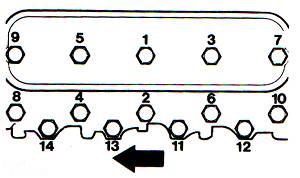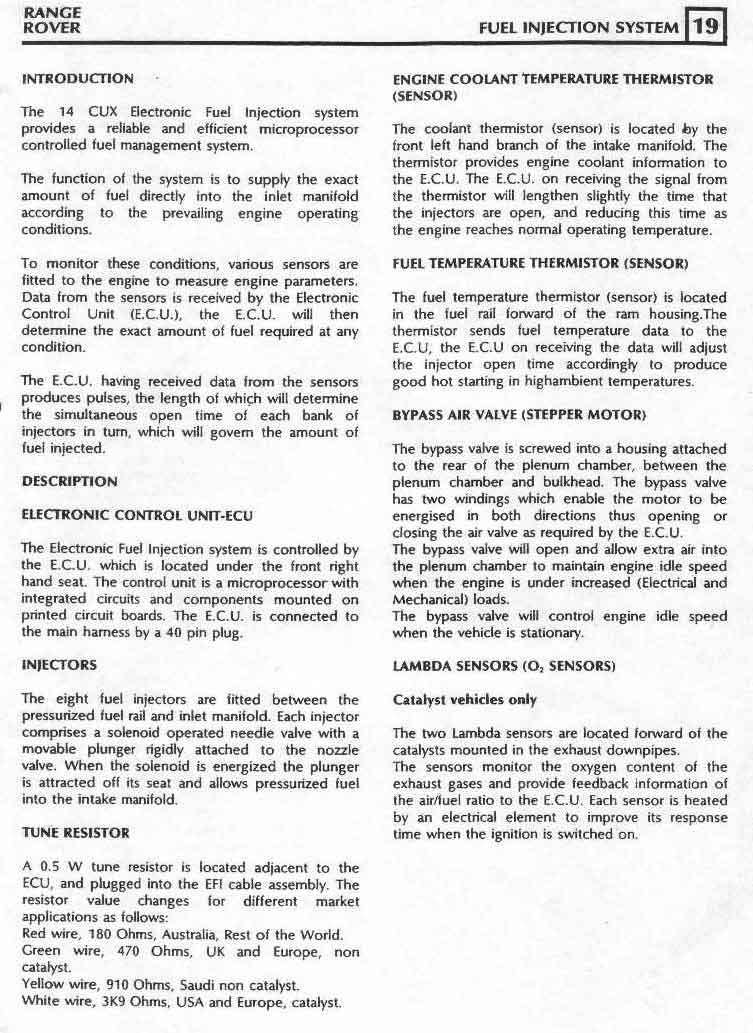
torque sequence
I have reports that the Rover engine has a special design fault in its heads.

torque sequence
The heads are held on by 14 bolts. The problem lies in the bolts 11-14. When they get tightened they put an load on the upper bolts, raising the heads by a slight amount. New engines are tight but as the engine gets older the heads allow hot gasses to enter the engine,oil and water galleys. This normally occurs only when high pressures= high load is applied on the engine. Those hot gasses do all sort of mess inside:
1. They heat up the water. Even a small amount rises coolant temp dramatically. As this occurs only under load it's difficult to diagnose.
2. They are responsible for oil leaks. Oil is pressed out by almost any seal as the vents can't take that much. Hard to find.
3. They make black sludge as they burn the oil. This sludge prevents the camshaft from being lubricated. Lobes wear off and power drops.
4. A good indication of this blow-by is that the tin seal plate in the V makes a bulge as it's pushed up by the pressure. You can see this plate from front or rear under the intake manifold.
All pre 96 V8's with the 14 bolt heads (yes that's all
of them) have this problem to some degree, Its
not maybe causing a big problem (or so you think) but
it is steadily killing of the detergent's in your oil.
Older engines seem to suffer more, as they usually get
less frequent Oil changes though they actually need far more. The secret
of the correct oil change interval, is not at 3000 or 5000 miles, but when
the oil is visibly contaminated and no longer able to do its job efficiently.
Most owners do not realize that the quality and detergent level of an oil
are actually far more important then its viscosity. A "reputable oil" changed
often is far better for your engine than far more expensive synthetic oils
that are changed less frequently.
All post 96 Rover V8 engine's no longer have the outer
4 head bolts on each bank, this is what the
engine has always needed, but took Rover 25 years to
realize this. Here is what you can do.
1. Do Nothing,
Well Rover got away with it for 25 years. Its a far off long term problem
on new
engines and an immediate problem on all pre 96 used medium
to high mileage engines, of all assumed
conditions.
2. Use conventional Tin (Shim Steel ) Gaskets "To retain compression ratio," This is actually better than it may seem, you can (we would ) refit the outer 4 offending bolts as Rover but torque them to only 20-25ft/lb. so they fill the hole but have no detrimental effect, this is generally the best option if your "Head and Block" faces are new or near perfect order
3.Fit Composite Gaskets,
This is the surest way of getting the best Head gasket seal,. but unlike
the above option, will lower the compression ratio by a factor of about
0.6-1. (Important to some but not
to most). Composite gaskets should also be considered
when ultimate reliability is far more important then the slightly
reduced reliability factor shim steel gaskets and when power is less important.
REMOVING YOUR CATS
by Lorne Goldman
Many post 1990's Plus 8ers have gone to their dealers with a plea for more power. Often enough, the suggestion is to remove their catalytic converters and replace them with straight through stainless pipes. Frequently, this is sold with a very expensive stainless exhaust system. Most often the resulting performance is a huge disappointment with the car operating poorly on acceleration and also smelling of petrol. The victim re-installs parts of the old system with no gain whatsover and a large loss to their pocket. What is wanting is 15 minutes and a £10 part or, better still, a new fuel map (350£).
You have to first understand that the Hotwire fuelling
system used through most of the 90's went through a number of modifications.
Each time once of these occurred a "patch" was found to adapt the system to
added-on items. The old systems are still inherent in
each later one. This is not uncommon with EFI systems.
In the case of the 1990s "cat" cars, a special set of resistors
were installed in the wiring loom to allow the cats to work and have their
data properly assimilated into the ECU (and its resulting signals to the
injectors). If you feel along the wiring loom, you will
come to a "lump"..that is it!.
If you uncover this lump carefully you will find it has
a plastic cover. The colour of this cover is of paramount importance! If
it is white, it is the original that came with the car. If you have removed
your cats and that is this colour is a BIG error. The component, a tune resistor, must be changed
to the green plastic when cats are removed. (It is easy to confirm by checking whether the loom
has been opened up.) If it hasn't, you have your answer to the poor performance.
The green covered one allows the ECU to effectively ignore
the missing cats. With it, the fuelling system and the car should
operate properly and (more robustly) and with a good sound. If the item
has not been changed, then the input to the ECU will interpreted by the
ECU as a presence of an engine problem and it will revert to a "limp home" setting programmed for cases of engine anomolies. This special
setting protects the engine by making it run super rich....not
an unreasonable decision in that an engine running rich when under stress
is safer for a short period.When super rich, the engine will sound deeply loud and
sluggish and smell of fuel and oil (running very dirty). You will lose
much of your acceleration and "pep" but you can safely rev higher. Your
gas mileage will be much worse. Sound familiar?
Here is more on the subject...look at the section on the Tune Resistor.
Land Rover never designed a fuel map for Lambda sensors and no cats. So the new tune resistor will also ignore the sensors. That is not good becuase much of the snesivity and benefit of the HotWire system relies on the Lambda information it receives. The ideal solution is to buy a Optimax/Tornado chip to replace the original fuel map.

Plus 8 Water Pump
from the eMog archives
There is a rhythmic squeak coming I think from the pulley of the upper rotor on the front of the 3.5 Vitesse engine ???water pump???) Peter +8 R10343
The present pumps are sealed units sounds like replacement
time but you can tell if so as there is a small hole just under the shaft
on the bottom side if you see it wet or dripping antifreeze, that indicates
the
seal is going and it's time for a new one.
On the inside of the pump your antifreeze works as a lubricant.
John H. Sheally II
Hi Peter,
John makes a good analysis. Of course, in the last year, unsealing "sealed" units has become a second profession for me. (smile) Here is some other ideas.
BTW, the easiest way of determining whether the pump is to blame is to loosen or remove the fan belt and run the car for a minute. If the noise is gone the water pump is the culprit.
If your fan belt is not in fine fettle..(examine it carefully
while it is off, that can cause a squeak. If it has been over tightened..the
pump will become damaged sooner or later (mostly sooner). If the water
pump
shaft bush has become worn it will either leak or cant
the fan just slightly and then one blade will rub against the face of the
timing cover to which the pump is attached and that will make a "rhythmic
squeak".
This happened to me four years ago...right in the middle
of my sacrosanct driving season. I had a long weekend planned the next
day and I was NOT going to lose it waiting for a new pump! I had a gasket
but
only one..so the idea of adding gaskets to space the
blade out a little was not easily possible. Instead, I set the pump in
a vice, angled a file the blade exactly as the face of the timing cover
was and turned the pump until I filed a few thousands off the offending
pump blade and it turned clear. I reinstalled the pump and had a great
weekend.
The new one arrived and I got busy and one thing lead to another and the next thing I know that old pump has done another 50-60K kilometres until today without any problems whatsoever. I guess I will replace it when I remove the engine this Fall and have a local machine shop refurbish and press fit a new bush and bearings for a few dollars and keep it as the spare rather than new one.
All that being said, please do what I say..not what I
do. Replace the pump if you have any doubts...mainly because the water
pump for your engine are getting rarer. You probably need a non-viscous
Vitesse water pump...you may get by with Sd1 and it would be wise to take
an image of
it and send it to your supplier if it is non-Morgan fellow.
NOW here's where the fun choices begin...
Morgans do not need the viscous pump that would normally have come with our engines because they do not use the mechanical rad fan attached to the water pump as do others users of the same V8...we have no room for that fan so an electrical fan is used instead. Even with the non-viscous pumps the nose must be cut down to clear the cross-bar. With the right equipment and man, it takes less than a minute to cut the nose down...(one has to be careful not to burn the pump as the nose moves with the blades). I have had it done twice..both times without charge.
Because of this cut..a refurbished or new "Plus 8" water pump is sold for 153.20 pounds by a major Morgan supplier. (I do not know the Works' price). In my case, I purchased my spare Vitesse pump spanking new and shiny from Rpi for 65 pounds.
The only trick to de-installing and installing it, (aside from the customary need of triple jointed munchkin fingers) is to remember to put the pulley on loosely before you re-install it. If you forget the pulley, you will either have to remove the pump again or push the engine back on its mountings with largish neighbours and a steel bar.
Lorne